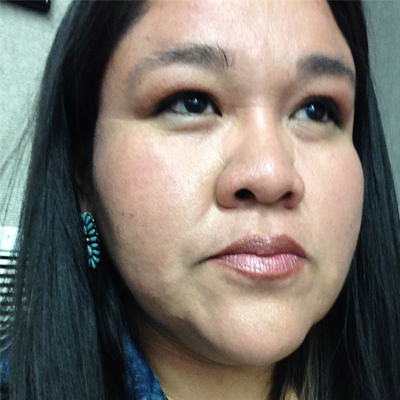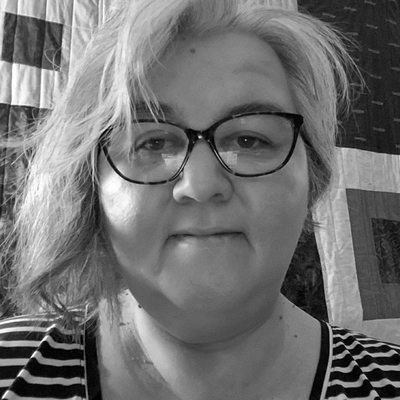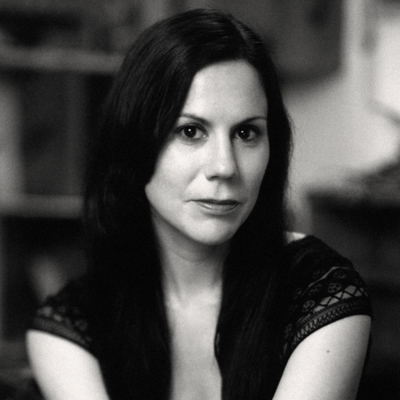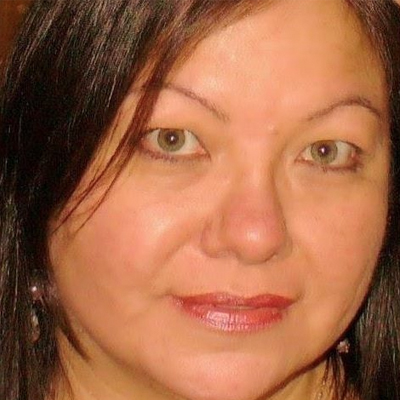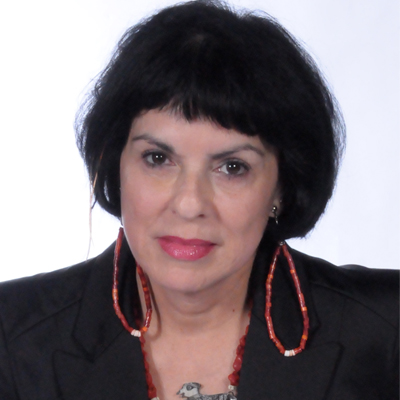In my Mojave culture, many of our songs are maps, but not in the sense of an American map. Mojave song-maps do not draw borders or boundaries, do not say this is knowable, or defined, or mine. Instead our maps use language to tell about our movements and wonderings (not wanderings) across a space, naming what has happened along the way while also compelling us toward what is waiting to be discovered, where we might go and who we might meet or become along the way.
This feature of indigenous women is meant to be like those song-maps, to offer myriad ways of “poetic” and linguistic experience—a journey through or across memory, or imagination, across pain or joy or the impossibility of each, across our bodies of land and water and flesh and ink—an ever-shifting, ever-returning, ever-realizing map of movement, of discovery, of possibility, of risk—of indigenous and native poetry. It is my luck to welcome you to this indigenous space and invite you into the conversations of these poems, languages, imageries and wonders. In this installment of the bi-monthly feature, I’m pleased to share the work of Tacey M. Atsitty, Sammie Bordeaux-Seeger, Jennifer Elise Foerster, Tiffany Midge, and LeAnne Howe (full bios below).
–‘Ahotk, Natalie Diaz
*
Tacey M. Atsitty
When Water Came to Me
For a moment, all that once ribbed between us fell still,
In a moment, all that once ripped between us falls still,
So I thrust my thighs forward, curls to break our still.
These aren’t natural occurrences for me, he said.
This is how nature occurs in me, I said.
We had enough drip between us to run off and shed—
I thought to weigh in, to starve myself off in ~
I thought to wade in, to stave myself off with ~
But when my hair is down, I stand as a horse in ~
I thought I had learned to wade without waiting.
Yes, I thought I had learned to wait without wading,
When my legs are wet up to here, I come close to fading
in— water: it’s so oblivious; it eats through my coat hair,
eats through my coat hair and leaves me winter bare.
Into Rain
it’s too much to press play to embrace
me again atop the stairs, an upward
pushing away of my skirt, to try out
our lungs again—
I would’ve snapped
pearl buttons shirt shut
over and over, would have
scooped water from barrel
to his lips every fifteen minutes
he came around. Instead he takes
a gallon, holds it between his knees
before peeling the plastic from its neck.
That’s when thunder left us
to breathe in rainfall, left to seep
out our sides—
Just when I was no longer afraid to spill
over, and take any ledge or mouth, he gambles
on a side creek. Just when I came
to drip—
He takes the Valerian blossom then left
just as we began to slide
Sammie Bordeaux-Seeger
60 Songs About Quilting
1) Sometimes all the heirlooms you make have to be sold to cover your daughter’s rent.
2) Selling some quilts is like selling children.
3) Some quilts you make scare you, just like stories writers tell scare them, even as they tell them.
4) I remember the first quilt I made when I was 22. I didn’t finish it because all the others in that class who finished their quilts used them for funerals.
5) That class taught me that the making of quilts was the beginning and end of grief.
6) I remember the quilt I was first groped under. I was nine. My mother’s boyfriend/my brother’s father, it was a quilt my mother made that had nine diamonds, not the usual eight you find in a star quilt. She tells stories about that quilt and laughs. I only remember the hand forcing me to hold a penis for the first time under that quilt.
7) Quilts can be both a comfort and a terror.
8) This quilt I am currently pressing has holes in it. All quilts are full of holes, but some can be seen, some not. I mend all the holes as I come to them.
9) It is a heartache to let go of a quilt I have made with my hands.
10) I sometimes wonder if we give away pieces of ourselves in these quilts.
11) I have found pieces of myself in quilts.
12) Every star quilt I have ever made now belongs to someone else.
13) I made quilts for my children for their graduations. One of my children has never graduated. She will get the best quilt.
14) Washing a new quilt before someone sleeps under it is washing away the quilt luck.
15) My quilts reek of smoke because I smoke while making them. I smudge. I smoke. I pop M&Ms like they’re pills to make me quilt faster. They work.
16) My friend told me M&Ms are my version of self-medicating. I told her the quilts are the medication.
17) I have made death quilts for all the people I loved who have died. I have watched my sad quilts lowered into graves with the remains of my beloveds. Those quilts glowed.
18) They say the Lakotas began to make star quilts to replace the buffalo robes meant to honor men for their greatness.
19) I say Lakota winyans began to make star quilts so they’d have something to do with their hands that wasn’t stabbing men for their greatness.
20) I am not a man hater. Do you honor a man for his greatness by wrapping him in a robe that shows your own greatness?
21) Lakota star quilts are made up of diamonds which form stars
22) Rihanna’s song “Diamonds” understands this. This is a Lakota song. “You and me, we’re like diamonds in the sky.”
23) There are 36 diamonds in one quilt block of an eight-pointed star. Each diamond is cut at a 45 degree angle. 288 diamonds make a star. I cut each diamond individually. I sew each diamond individually using ¼” seams. There is some math involved in quilting.
24) That white math teacher at the college believes Indians can’t do math. She doesn’t understand how math-y life and survival actually are.
25) The population of Indigenous people on this continent was estimated at 50 million pre-white contact. Some scientists believe it may have been as high as 100 million. At our lowest point it was only 200,000, post-massacres, diseases, and starvation. Today we are up to 2 million. Still less than 1% of the total population if you don’t count Mexicans, but we do. We count all our Indigenous brothers and sisters. Indians are the fastest growing population in South Dakota, and Indigenous are the fastest growing population on this continent. Someday we will be the majority again. How’s that for math?
26) Imagine how many baby star quilts it would take to welcome every newborn Indigenous baby.
27) That white math lady is paid by money generated by Indians going to college. She’s paid more than the Indian instructors for her trashy opinion that Indians can’t do math.
28) My poetry teacher told me to take the quilt pieces off my wall and put my poems there. That’s how I finished my master’s thesis. I wanted to say, I can write while I quilt. I am poeming and piecing all the time.
29) So many quilters make quilts with words in them. One put the treaties in her quilts. Another wrote “I can’t breathe” in black fabric on her quilt. I like to think my quilts speak without the need of words, but let’s face it, sometimes a quilt, like a poem, needs to be obvious.
30) I don’t hate white people.
31) I learned as much about quilting from whites as I did from Indians.
32) Quilts need all colors to be successful.
33) No one is ever going to write “All quilt lives matter!” so I will here. It doesn’t make sense.
34) I learned to speak white so I could write this poem in your Native language.
35) I didn’t really have a choice about learning to speak white.
36) There are some good white people. I don’t say this to appease or patronize. I mean good white people have enriched my life. If they did it out of guilt, I don’t care.
37) There are some bad Indians. I might be one of them.
38) I am both bad at being Indian and bad at speaking for Indians or speaking to Indians
39) I am not going to be good at being Indian until I stop judging my Indian-ness using shallow white terms.
40) I am a half-breed. The Lakota word for half-breed is “ieska.”
41) Ieska means “speaks white”. Also, “Interpreter” or “translator”.
42) Lakotas inherently distrust translators because of what happened to Conquering Bear.
43) I don’t speak fluent Lakota. I couldn’t begin to translate much beyond the shortest phrases. I “know” Lakota by listening to tone of voice and understanding about five hundred words and phrases.
44) To some Indians and whites, where you come from and how you were raised matter as much as your DIB, Degree of Indian Blood.
45) I am 35/64’s Sicangu Lakota.
46) I am enrolled at the Rosebud Sioux Tribe.
47) I was born and raised at Rosebud, South Dakota.
48) My tribal enrollment number begins 345-U-#####
49) It does matter that I am an enrolled member of a federally-recognized tribe if I want to sell my quilts as “authentic” Indian art. There is a federal law that mandates this.
50) Why is it called “Mandate?” Man + Date = An Order?
51) Who made up these rules and words anyway?
52) Hey, White Math Lady, Indians can do fractions, too! If nothing else, we know our fractions.
53) Can someone tell the white math lady that I learned algebra from a Lakota math professor who earned his Ph.D. in math from Notre Dame University?
54) Maybe you could also mention that he wrote an algorithm that is used to provide water to much of South America. Math = MniWiconi
55) To you White Math Teacher, I offer this proof that Indians can do math:
56) The star quilt is made up of pieces cut at precise 45 and 90 degree angles. The Isosceles triangle is not easy to create in fabric. The balanced 45 degree diamonds are faceted by 48 other 45 degree diamonds that must be perfectly pieced in order to fit together correctly, or the quilt with ripple.
57) Look at the perfectly square squares in each corner, how they create the straight line that bisects the center of the quilt.
58) Tell me about math, about geometry, about the Golden Mean, and I will show you the Lakota Star Quilt.
59) I offer you this proof that you have nothing to tell me about Indians and math and competency tests that you give as proof of your assertion: Indians were making star quilts before they had ever met fabric. They were called buffalo robes.
60) Perhaps if you believe Indians can’t do math, White Math Lady, you should go back to teaching your own, mathematically-competent people?
61) This quilt is made up of holes, of wholes, of halves and quarters and tiny stitches and big stitches and words and pain and memories and laughs and sweat and smoke and chocolate and my grandmother’s hands. This quilt isn’t about math or Indians or treaties or men.
![]()
Jennifer Elise Foerster
Sail
A butterfly supernova
spreads its silken winds.
Sea’s heavy snowflakes
feather from shore.
The reef blinks, electric eels
slip beneath the rock’s lip.
*
Our boat is a drowning cloud.
We follow the tide’s
wet-black eyes.
Canting the shoals—
glassworms, shells.
I tell you the moon
has floated beneath us.
A wave sweeps in,
stirs the clams. Crabs in their caverns
fan their claws as you and I,
scavengers for stars,
tin scraps stuck in mud flats,
float past the sea-wall’s clutches
of mussels, encircled by harbor seals
swimming under dusk.
*
On a drowning boat we drifted
south, counting moons,
humps of whales,
white pearls thrown by waves.
Sea, you said
you were never mine.
But I am always yours.
The stars are your wreckage—
ships I have lost.
*
Spiny urchins
ink,
swell.
Flesh—
ripped off the coral animal.
My chest
a rusted music box
chimes of dying reefs.
Day after day I open it.
Salty coffin
seahorse wreathed
how will I call you—
cloud scar?
Salve of grass
*
Beyond the snow’s
white-capped shores—
sea-ears heaped on the valley’s floor.
Once mangrove coasts
now shipbreak yards.
Hubcap, shark-finch, buzz of—words
are never enough, they do not make fire
nor rain for burning tankers,
beached infernal whales.
*
Casting ribbons of entrails
to a squawking sequence of gulls
above the outrigger poles of trolling boats’
darkened windows, stacks of crab traps.
Time is a raft of clouds when clean
swept are the tire-stapled railings of the sea
and dreamless, the fishermen
slapping on their rubbers
sloshing buckets of bloody scales
in the star’s cold machinery.
*
The echo of your oars
outside my window
still wakes me.
A flock of marsh birds
beats through fog.
When I open my mouth, my breath
steams the glass.
There is nothing to say
or trace on the sea.
Pulpit overgrown with grass.
*
Our boat is neither sky
nor sea.
We are windowed in a narrow bunk
watching the mast compass stars,
night wind rattle the sails.
Maybe we should head south
I tell you, the moon, a lanternfish
drifts over glass. I trace
the swim of Andromeda,
skim the coast of your back.
A breeze takes shape
across black-lit waters—
sails luff
windward, my hands.
Nightingale
I’ve heard the nightingale tapping at the window,
seen her singing in the pitch-black trees.
Slam against the piss-stained corner:
two girls coming home from a slumber party.
We had taken the back stairwell as a shortcut.
The train zippers
our crumpled clothes,
bodies’ contorted clocks—
a wing clamps shut the dark.
*
An old woman walks out in the moonrise.
She wakes the nightingales, pierces their throats,
steals the eggs and the blind chicks crackling.
The males are singing their joyous notes.
Later, I carried her into the woods
scratched off sap,
balm for her body
stitched us a new bark throat.
*
Tawny-feathered,
sutured throat,
night wind lashing the panes—
I wake up in damp sheets.
Old woman, immortal bird
run, mute, down the stairwell
dragging the little girl’s shadow.
*
A shadow is a house made of hours.
She slips through the window
when the men are asleep
to sing, unseen
in the moonlit boughs
her mute song buried in the valley.
*
I’ve seen the nightingale
rapping at the window,
heard her singing in the pitch-black trees.
Buried beneath groceries on the plastic seat
of a cross-town train route’s blinking streets
her old ghost, shuttling sloppy beside me,
nods, leers in the dizzying lights.
Her eyes in the window are black
and wet. The cold milk I am carrying
burns in my lap.
*
She whistles to me from the valley—
a night wind whistling through birches.
Tethered by stirrups
to a wild horse, I am winged
tearing through brambled clouds—
awake in a bathtub to an old woman
sponging down my bloody abrasions.
She braids my hair into a loose knot
as outside, apples
sink into the wet field.
*
I have grown a child of hours.
Sitting on a bench by the docked boats
the old woman approaches
with a shawl-covered cage,
a plastic doll strapped to her breast.
I feed my crumbs to the birds
as they lurch, heads thrust
through grating—
her gray teeth,
sparked matches.
A little girl with cardboard wings
tugs at my dress. Barefoot,
we shift down the littered street.
*
The old woman sleeps
in her cardboard house.
In windows, birds
hang like wooden crosses,
wings tick-tocking
the night’s contorted face.
*
I have buried my song in the valley.
Left my hair,
knotted wreaths
for birds to comb from the ledge.
Old woman, immortal bird
perched in your silent, forever-green glade
will you weave me a nest,
lay me down in the shade?
I have slipped through the cracks
of the clock-hands,
peeled the bark from my throat.
*
In gauze light—taut wings.
Netting of blue veins,
slick black branches.
I gather a handful for the empty vase,
tell the girl:
leave the root in the ground,
cut just above the node.
I am harvesting songs from the valley,
lean into the scent of her tender skull—
her hair like the feathers
of this morning’s nightingale
blown out on the roadside
bones scraping slate-gray sky.
![]()
Tiffany Midge
Why I Don’t Like “Pussy” Hats
I don’t like “pussy” hats for the same reason
I don’t like the “s word,” as in “S Valley,”
or “S Bay,” “S Creek,” “S Peak,” “Big S Mountain.”
Several of these place names have been
changed—“Isqúulktpe,” Umatilla for “throat-slitting place.”
“Piestewa Peak,” named for Lori Ann Piestewa,
first known Native American woman
to die in combat, first female soldier
killed in action in the 2003 Iraq War.
I don’t have the luxury, or the class status
to use appellatives like “pussy,”
or “nasty.” They’re not re-claimative terms
for someone like me. “Pussy” hats speak liability.
“Pussy” hats speak caste system.
“Pussy” hats speak privilege.
A carefree embrace that lurks without threat.
“Pussy” hats are not transgressive.
“Pussy” hats are an emblem, a tool of privilege.
When my people march and organize
the cops and paramilitary are deployed.
In the Women’s March in Washington
the demonstrators were free from authoritarian presence.
I don’t enjoy that same carefree, flagrant luxury
my white sisters take for granted.
Because I’ve known the “S word.” I’ve heard
it spoken and used like a weapon
to belittle, to declare supremacy, to make war.
I’ve seen it tossed out of car windows,
on school playgrounds, in work spaces.
Sharpened like obsidian, used to flay open, used
to humiliate, to disgrace,
to bludgeon, used like an axe.
I’ve seen it used in a thousand different ways.
I don’t like “pussy” hats for the same reason
I don’t like the “s word.” I don’t like
the “s word” for the same reason
I reject injustice, ongoing colonialism,
racial divide, war, or apartheid.
Literature of Resistance Re-Imagined with Pepsi
Pepsi in the Blood
The Lone Ranger and Pepsi Fistfight in Heaven
Pepsi Ceremony
House Made of Pepsi
She Had Some Pepsi
Bury My Pepsi at Wounded Knee
Pepsi is Red
Pepsi Died for your Sins
Pepsi Medicine
Black Elk Pepsi Speaks
Why I am a Pepsi
Lame Deer, Seeker of Pepsi
Grass (Pepsi) Dancer
Spiderwoman’s Pepsi
The Pepsi of Columbus
Pepsi Spirit
My Brother was a Pepsi
![]()
LeAnne Howe
from Savage Conversations
© forthcoming from Coffee House Press, 2019
President Abraham Lincoln gave the order to execute thirty-eight Dakota Indians in Mankato, Minnesota for their actions in the Dakota War against white settlers who had first stolen their lands, then their rations, and raped their women. At 10 a.m. on December 26, 1862 the synchronized hanging of thirty-eight Dakotas was, and continues to be, the largest mass execution in United States history. Four thousand settlers attended the execution.
Fast-forward eleven years to November1873. Dr. Willis Danforth of Illinois treats Mary Todd Lincoln for “nervous derangement and fever in the head.” He notes peculiar symptoms. Mrs. Lincoln tells him that someone is removing wires from her eyes, especially the left one, and cutting the bones from her cheeks. She attributes the fiendish work inside her head to an Indian spirit. Nightly, she claims, he lifts her scalp and replaces it by dawn, sometimes cutting a bone out of her cheek. “The Indian,” she says, “slits my eyelids and sews them open, always removing the wires by dawn’s first light.”
Apocrypha
June 1875
Bellevue Place Sanitarium 333 S. Jefferson Street, Batavia, Illinois
Mary Todd Lincoln’s suite at Bellevue Place. Although there is only a small bed and a bureau in her bedroom, Mary believes her residence sprawls over three large sitting rooms, one containing a piano. Her residence is chocked full of trunks, six carpetbags filled with footstools, silk curtains, jewelry, fifteen pairs of kit gloves, and a few vials of laudanum hidden among her things.
Savage Indian sits in a dark corner of the room. He wears a black Vigilante Town Coat, the one he was hanged in. The coat droops open because the hangman’s wife cut off the buttons to use on her new frock.
Mary Todd Lincoln
Before you can think, you forget and then remember
A dress of blood, gloves I refuse to wash.
Ever.
What is it to a wild Indian? The president is shot.
Fool, I was his all-in-all, his Molly, his Child Wife and Mother, his Puss.
Savage Indian Thoughtfully
Well, . . . he called me Puss, too.
Savage Indian Feeds Gar Woman
June 1875
Bellevue Place Sanitarium 333 S. Jefferson Street, Batavia, Illinois
3 a.m. A slight breeze blows the gauzy curtains open. Moonlight floods the room.
Mary Todd Lincoln
Cleave unto me,
Seduce,
Fetter,
Handcuff,
Wheel clamp the irons,
Savage, I cease all protestations.
Savage Indian Checks her scalp for nits.
Wipes excess bear grease from his hands on her nightdress.
Fills her gaping mouth with fescue and sod.
How does it taste, Gar Woman?
You said,
“If they are hungry let them eat grass,
Or their own dung.” (1)
Trader Andrew Myrick’s words
Lower Sioux Agency, August 15, 1862, but
Your sentiments spoken more than once.
Mary Todd Lincoln Swallows
June 9, 1875.
I am in possession only of my name,
Mary Todd Lincoln, bewildered with a joy so noble
I too, could expire
Savage Indian
Who says Abe is dead?
Now I Lay Me Down
June 1875
Bellevue Place Sanitarium 333 S. Jefferson Street, Batavia, Illinois
4 a.m. Mary Todd Lincoln sits in a chair in her bedroom. A small candle blooms on the bureau.
Mary Todd Lincoln
Tattoos adorn his arms and hands.
Like night-blooming cereus they prick the skin, slash my will
The Savage says nit picking takes time and patience, but can be very
enjoyable for both parties.
Savage Indian Combs her oily hair.
Immerse any nits or lice in kerosene water.
Pull them from the hair; drop in bowl
Pin cleaned sections of the hair aside,
Scissor divided segments close to the scalp. Wait.
Mary Todd Lincoln
These many days after dear Abraham, I have come to this,
Hairless with a deformed cheek,
Those of us with eyes sewn open
Perceive nothing to fear
Not
Gunpowder, walls afire,
A Wild Dakota Indian
The Presidential Box at Ford’s Theatre,
A hangman’s noose
Savage Indian
Silence, Gar woman!
Ever so gently he takes the sharp flint knife from his leather pouch. They assent to their nightly ritual, the one she craves.
Mary Todd Lincoln Picks up the mirror and studies her face.
Her thin upper lip curling into a smile.
I faint from the ecstasy.
__________________________________
1. http://history.nd.gov/HP/sites/abercrombie/abercrombie_history2.html
![]()
Tacey M. Atsitty, Diné (Navajo), is Tsénahabiłnii (Sleep Rock People) and born for Ta’neeszahnii (Tangle People). She is a recipient of several awards and prizes. She holds an MFA in Creative Writing from Cornell University. Her work has appeared or is forthcoming in POETRY Magazine, Kenyon Review Online, Prairie Schooner, Crazyhorse, New Poets of Native Nations, and other publications. Her first book is Rain Scald (University of New Mexico Press, 2018).
Sammie Bordeaux-Seeger is a Sicangu Lakota poet, mother, and quiltmaker living and working on the Rosebud Reservation in South Dakota. Sammie is a 2016 graduate of the LowRez MFA program at Institute of American Indian Arts, Santa Fe. Sammie has previously published poems in the Tribal College Student Journal, Yellow Medicine Review, Connotations Press Online Journal, and has been featured in a Poet Spotlight on the Best American Poetry blog.
Jennifer Elise Foerster is the author of Leaving Tulsa, published by the University of Arizona Press in 2013. A Mvskoke citizen, Jennifer is an alumna of the Institute of American Indian Arts and the Vermont College of the Fine Arts. She has received a Lannan Foundation Writing Residency Fellowship, was a Wallace Stegner Fellow in Poetry at Stanford University, and is currently pursuing her PhD at the University of Denver.
Tiffany Midge’spoetry collection The Woman Who Married a Bear (University of New Mexico Press) won the Kenyon Review Earthworks Indigenous Poetry Prize, and a Western Heritage award. Her work’s been featured in McSweeney’s, World Literature Today, Okey-Pankey, The Butter, Waxwing, and Moss. She writes a humor column for Indian Country Media Network, and aspires to be the distinguished writer in residence in Seattle’s Space Needle.
LeAnne Howe (enrolled citizen of the Choctaw Nation) author of Choctalking on Other Realities (2013) is the winner of the inaugural 2014 MLA Prize for Studies in Native American Literatures, Cultures, and Languages. She received the Western Literature Association’s 2015 Distinguished Achievement Award for her body of work. Novels Shell Shaker, (2001), Miko Kings, An Indian Baseball Story, (2007), poetry Evidence of Red, (2005), and she’s the co-editor of Seeing Red, Pixeled Skins, American Indians and Film, (2013). She’s the Eidson Distinguished Professor of American Literature in English at the University of Georgia.


